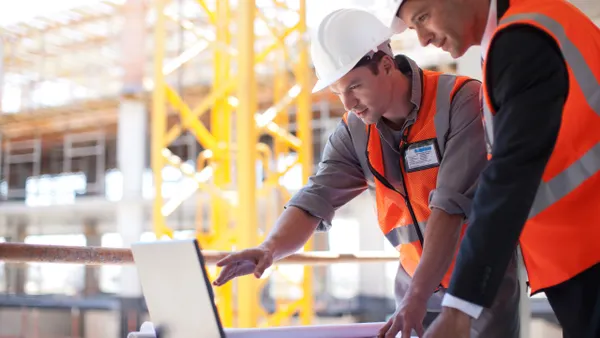Dive Brief:
- Shimizu Corp. announced it is in the final stages of developing several models of autonomous robots that it plans to deploy to a high-rise construction site in Osaka, Japan, later this year. The Japanese construction company said its robots — designed to carry material, work on floors and ceilings and weld steel columns — will help ease the country’s labor shortage.
- With Japan's birthrates trending downward, Shimizu expects the country's construction labor pool to plummet from 3.4 million workers in 2014 to 2.2 million by 2025.
- The robots do have limitations: Because construction work is often less repetitive and more delicate than assembly line tasks, Shimizu estimated that only 1% of it can be handed off to the robots initially. In addition, Japanese regulations and safety concerns will keep the robots restricted to night shifts when no human counterparts are present, the Associated Press reported. Robotics may also be best-suited to high-rise projects, where work repeats from floor to floor.
Dive Insight:
Like Japan, the United States is in the throes of a skilled labor crisis. In the January 2018 National Association of Home Builders/Wells Fargo Housing Market Index, builders cited cost and availability of labor as the top problem they’re facing, with 82% of respondents saying it was a problem last year and 84% saying it’s a problem they’re anticipating in 2018.
The latest jobs report from the Bureau of Labor Statistics and the NAHB found there were 196,000 open construction sector jobs in February, a 16% increase from last year.
Could robots be the answer to solving at least some of the industry’s woes? “The opportunity for growth in robotics in construction is huge,” Dan Kara, robotics researcher at global technology business research firm ABI Research, told Construction Dive last year.
There are certainly countless tech companies working on developing new robotics technologies. One of the most well-known technologies is SAM, the Semi-Automated Mason, which can lay 3,000 bricks per day at a rate 500 times faster than a human mason. Still, it’s not completely autonomous. Humans are required to load the bricks into the machine and to clean up mortar behind it. In Australia, the Hadrian X brick-laying robot is said to move even faster with a capability of laying 1,000 standard bricks per hour.
Startup Built Robotics is working on autonomous construction equipment such as bulldozers and excavators. In another approach, Sarcos Robotics is developing machines that could take on riskier construction tasks, such as an exoskeleton that could give workers more strength to boost efficiency and reduce the rate of injury. Another is a set of robotic arms for welding.
In a report released in January, the Midwest Economic Policy Institute estimated that about 49% of all construction jobs could be automated — 35% for laborers, 50% for carpenters, 42% for electricians, 50% for plumbers and 88% for operating engineers. That would result in the displacement or replacement of 2.7 million construction workers by 2057. In its report, the Institute recommended several tactics to prepare for this possibility, including adapting apprenticeship programs to “re-skill” employees as jobs in their field become more prone to automation.
In the meantime, several construction organizations are working on initiatives to get more workers into the trades. The Skilled Labor Fund is raising money for scholarships, trade school accreditation and training facilities. Home Depot’s Skilled Trades Initiative aims to train 20,000 people while Track to the Trades from Lowe’s supports employees wishing to pursue a skilled trade. Fine Homebuilding’s #KeepCraftAlive hashtag campaign highlights passion in the trades while raising money for scholarships.













